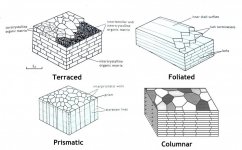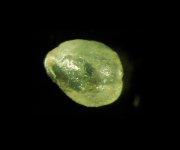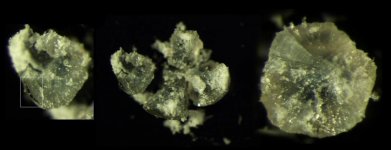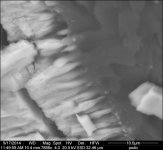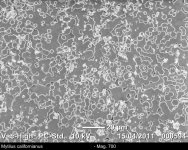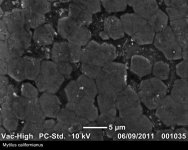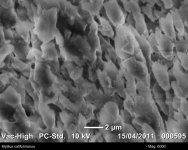Mostawesomecoffee
New Member
- Joined
- Jun 16, 2014
- Messages
- 44
So, obviously nacre is comprised of alternating layers of calcium carbonate (in the form of argonite) alternating with layers of biopolymers. According to the wikipedia article on nacre, argonite structures are 0.5 nanometers in thickness. This is incredibly small. When looking at radiographs of cultured pearls online, it looks as if there is a gap between the nucleus and the nacre. At first I thought that this gap was a flaw; that the nucleus was seperated from the nacre. I don't think this is the case, though. I've seen this "gap" on many radiographs.
What I'm guessing is the answer to this peculiarity is that from the start of cultured pearl formation, nacre doesn't lay down uniformly. In other words, nacre is not comprised of 0.5 nm argonite alternating with equally minescule layers of biopolymer throughout its entire thickness. It seems that a cultured pearl starts by laying down a VERY thick layer of biopolymer before it even starts to lay down argonite. Once argonite starts to be deposited, only then with there be alternating layers of argonite and biopolymer on a very small scale.
Also, in some of these radiographs, there seem to be thick "bands" of nacre, that are quite a bit thicker than 0.5 nm, since they seem to account for about a tenth of the thickness of the nacre layer. Why is this? Does this represent growth cycles, the way a tree has rings?
Finally, between some of the "bands", there seemed to be spaces. Again, I don't know if these spaces represent flaws, or if they are indicative of biopolymer deposition without argonite deposition.
Any thoughts? Thanks.
What I'm guessing is the answer to this peculiarity is that from the start of cultured pearl formation, nacre doesn't lay down uniformly. In other words, nacre is not comprised of 0.5 nm argonite alternating with equally minescule layers of biopolymer throughout its entire thickness. It seems that a cultured pearl starts by laying down a VERY thick layer of biopolymer before it even starts to lay down argonite. Once argonite starts to be deposited, only then with there be alternating layers of argonite and biopolymer on a very small scale.
Also, in some of these radiographs, there seem to be thick "bands" of nacre, that are quite a bit thicker than 0.5 nm, since they seem to account for about a tenth of the thickness of the nacre layer. Why is this? Does this represent growth cycles, the way a tree has rings?
Finally, between some of the "bands", there seemed to be spaces. Again, I don't know if these spaces represent flaws, or if they are indicative of biopolymer deposition without argonite deposition.
Any thoughts? Thanks.

